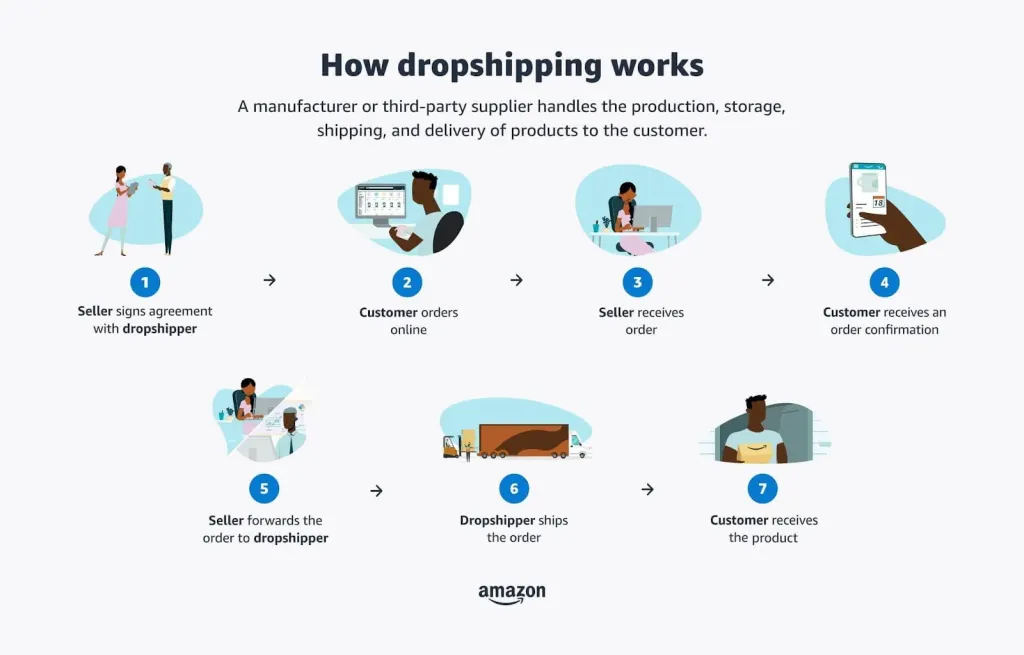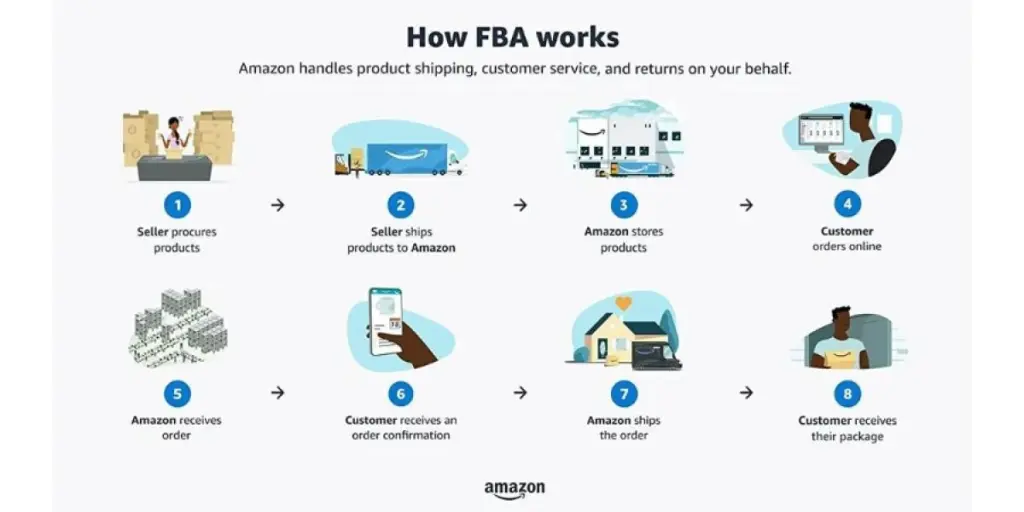Amazon holds the largest market share among eCommerce companies, amounting to 37.8% of all sales. One contributing factor to its success is the availability of different fulfillment business models for its sellers. These business models encompass the procedures of storing, packaging, and delivering products to customers on behalf of their sellers. Amazon provides two main options: Fulfillment by Amazon (FBA) and Fulfillment by Merchant (FBM). Dropshipping, which operates as a distinctive business model, falls under the FBM category.
Whether you’re building your Amazon empire by selling your own products or supplementing your income by selling used items, it’s crucial that you choose the most suitable fulfillment method for your business. Determining which works best depends on several factors, such as your business’s current state, your financial resources, and your preferred level of control. Either way, you can assign the responsibilities of storing goods and fulfilling orders. This enables you to concentrate on other aspects of your business.
In this article, we will look into the importance of fulfillment, closely examine Amazon FBA and dropshipping, go over their benefits and drawbacks, and highlight their key differences to aid you in determining the optimal choice for your eCommerce store.
The Importance of Fulfillment
Fulfillment plays a crucial role in the success of your business. Did you know that 56% of abandoned shopping carts are linked to delivery concerns? By selecting the right order fulfillment service, you can gain a competitive advantage. Such a service assists you in various ways:
- Managing inventory and storing products efficiently
- Packaging and labeling orders accurately
- Handling customer relations effectively
- Ensuring timely shipment delivery and providing tracking details
- Providing up-to-date information on available stock
- Attracting customers with fast and affordable shipping options
- Processing product returns and exchanges smoothly
Reliable fulfillment services are essential as they help establish trust with customers and ensure their satisfaction. However, if product delivery fails to meet customer expectations or items get damaged during transportation, it can negatively impact your business. These fulfillment issues can lead to the loss of customers and hinder growth.
What is Amazon FBA?
Fulfillment by Amazon (FBA) is a convenient service that lets you delegate order fulfillment to Amazon. FBA enables you to ship products to an Amazon warehouse at a competitive rate. When a customer buys your product, Amazon takes care of picking, packing, and shipping the order. They even handle customer service and returns.
However, it’s important to note that Amazon charges fees, which should be considered when setting prices. As an Amazon seller, you will incur a few fees, particularly if you use FBA to fulfill orders. These are the main Amazon FBA fees:
- Fulfillment Fees: These fees cover the cost of Amazon packing and shipping your products to customers. The item’s size, weight, and destination are among the factors that determine them. Amazon provides guidelines to help estimate these costs accurately.
- Referral Fees: Regardless of whether you use FBA or handle fulfillment independently, referral fees are charged. Varying by category, these fees are a percentage of the item price and support Amazon’s platform, customer support, and marketing opportunities to expand your customer base.
- Storage Fees: Amazon stores your inventory in their fulfillment centers until it is sold. Storage fees are charged for housing your products and depend on factors like inventory size, weight, and time of year.
This is how you can set up Amazon FBA for your eCommerce store:
- Step 1: Access your Seller Central account and set up FBA.
- Step 2: List your products in the Amazon catalog and designate them as FBA inventory.
- Step 3: Prepare your products for transportation to a fulfillment center by following Amazon’s packing guidelines and shipping requirements.
- Step 4: Create a shipping plan, print Amazon shipment ID labels, and dispatch your shipment to Amazon’s fulfillment centers.
When the fulfillment center receives your products, they’ll be available for sale.
What are the Pros and Cons of Amazon FBA?
Amazon FBA has helped countless eCommerce entrepreneurs improve and scale their businesses with Amazon’s logistics, infrastructure, and customer support. However, while FBA presents various advantages, it also has some disadvantages. Let’s delve into a detailed examination of the pros and cons of using FBA.
Benefits of FBA
Convenience
By utilizing Amazon’s fulfillment services, all aspects of order fulfillment are taken care of for you. The manual and time-consuming task of packaging and shipping orders every day becomes a thing of the past. FBA provides you with a dedicated team of warehouse employees who handle every step of the process. This enables effortless business expansion without worrying about warehouse space or hiring additional staff. This is particularly significant as your order volume increases.
Prime Shipping
When you use FBA to list your products, they become eligible for free shipping. Qualified FBA listings are marked with the Prime logo, indicating to customers that Amazon takes care of packaging, delivery, customer service, and returns. Using FBA, your listings can reach Amazon’s extensive Prime member base, which consists of nearly 200 million members.
Customer Service Management
Using FBA means the customer service team of Amazon takes care of addressing your buyers’ inquiries. Customers have the convenience of reaching out to Amazon at any time. This service is provided at no additional cost, except for the Returns Processing Fee, which applies to specific product categories.
Effortless Return and Refund Policies
With Amazon’s FBA program, customers can access a user-friendly return center to initiate various processes, including returns, refunds, replacements, and reimbursements. This customer-centric approach ensures easy assistance for clients seeking to return their purchased products.
Build Customer Trust
The Prime logo assures customers of quick shipping and convenient access to Amazon’s customer service for support. Moreover, your products will typically be delivered in an Amazon-branded package, enhancing their perceived value for your customers. This instills trust and confidence in their purchase experience.
Expand Global Reach
Amazon FBA enables you to expand your business by accessing a global market. For instance, the FBA Pan-EU program facilitates swift delivery across European countries. Additionally, leveraging FBA Export allows you to broaden your online business presence in over 100 countries.

Facilitate Business Growth
Amazon’s fulfillment centers are designed to accommodate your inventory with no minimum requirement for the number of products to be sent. With FBA’s specialized services, you can expand your business without the need for additional capital or hiring more workers.
Multi-Channel Fulfillment
Extend a Prime-like delivery experience to your customers with speedy shipping options for orders placed on any platform, be it your own website, other online marketplaces, social media shopping sites, or direct-to-customer websites. Seamlessly create a multichannel fulfillment order and ship products to non-Amazon customers, broadening your reach beyond the Amazon platform.
Drawbacks of FBA
Substantial Fees
One major drawback of FBA is its substantial fees, which can reach 30–40% of your product price, depending on item size and weight. Calculating these fees in advance is vital for profitability assessments. Aside from the fees mentioned above, selling plan fees and occasional long-term storage fees should also be considered.
Threecolts’ SellerBench can track your fees daily and work with Amazon to rectify any inaccuracies and seek reimbursement for previous overcharges.
Inventory Capacity Restrictions
Amazon has introduced a storage capacity system for FBA to prevent sellers from exceeding inventory limits. Your Inventory Performance Index (IPI) score and sales history will determine the quantity you can send in.
Increased Return Rates
Although it offers convenience to customers, the simplicity of returning items on Amazon may result in higher return rates than other online marketplaces.
What is Dropshipping?

Dropshipping is a business method where sellers delegate the tasks of acquiring, storing, and delivering products to a third party, usually a supplier. With dropshipping, you can sell products online without buying inventory beforehand. It’s a favored model among sellers on platforms like Amazon, eBay, and Shopify due to its simplicity and low initial investment requirements.
Amazon dropshipping falls under the Fulfilled by Merchant (FBM) business model. With Amazon dropshipping, you can showcase products and run an online store. Once a customer makes a purchase, you forward the order to the dropshipper and inform the customer that their products are being shipped. The dropshipper then handles the actual fulfillment process, though under some agreements, you may still be in charge of customer service. In contrast, the dropshipping service handles the physical aspects and delivery.
It is essential to understand that Amazon enforces a dropshipping policy that must be adhered to in order to avoid penalties. Any violation of this policy can result in the loss of selling privileges through FBM and even the suspension of your account.
To fulfill orders using a dropshipper, keep the following guidelines in mind:
- Ensure that all invoices, packing slips, external packaging, and any accompanying information exclusively identify you as the seller. There should be no mention of your supplier or manufacturer.
- Avoid acquiring items from alternative online vendors and arranging direct shipment to your customer.
- Remove any packing slips, invoices, external packaging, or other items that disclose the participation of a third-party dropshipper before sending out the order.
- Take responsibility for accepting and processing returns from customers.
- Abide by all of the Amazon Services Business Solutions Agreement.
Amazon dropshipping involves three key players: the seller of record (SoR), manufacturers, and wholesalers. As the SoR, you’re responsible for selling products to end consumers, setting prices, recording revenue, and handling sales tax. Manufacturers produce goods, and while buying from them can require bulk purchases, some offer dropshipping services. Wholesalers act as middlemen, buying from manufacturers and selling to retailers with a slight markup. Though their primary role is serving retailers, wholesalers may also provide dropshipping services.
The dropshipping process may differ based on the arrangements in place. Generally, the system starts with a formal agreement between the seller and the dropshipper. When a customer places an order online, the seller receives and acknowledges it. A confirmation message is sent to the customer for reassurance. The seller then shares the order information with the dropshipper, who handles packaging and shipping, ensuring the customer receives the products and completing the process.
What are the Pros and Cons of Dropshipping?
Around 20–30% of all Amazon sellers use dropshipping as a side hustle and still make a decent profit. This straightforward and low-risk business model offers benefits and drawbacks for which you should be prepared.
Benefits of Dropshipping
Minimal Investment
Dropshipping requires minimal investment compared to private labeling and wholesaling. You can even operate without inventory. Upon receiving payment for a sale, you can use some of the funds to acquire the product from your supplier, who handles shipping. This eliminates the need for an upfront inventory investment.
Lower Overhead
Dropshipping can reduce overhead expenses because you are not responsible for storing or shipping the products.
Location Flexibility
The dropshipping model allows you to run your eCommerce store from anywhere. However, it is crucial to verify the legitimacy and accessibility of your chosen dropshipping supplier to prevent potential problems with product shipments.
Full Automation
Operating a fully automated dropshipping business on Amazon is achievable with the help of various Amazon-specific marketplace management platforms like Threecolts, Jungle Scout, and ChannelAdvisor. These platforms enable you to automate most aspects of your business, allowing you to be hands-off for the most part.
Convenience
Researching for dropshipping is simpler with existing products from manufacturers on Amazon. Various software options like Threecolts’ SellerRunning can help expand your Amazon reach and assess the competition.
Drawbacks of Dropshipping
Stiff Competition
Competition is intense in the dropshipping industry due to low entry barriers. With other Amazon sellers offering identical products, differentiation is limited. As a result, price becomes a critical factor in determining whether a product stands out.
Smaller Profits
Dropshipping businesses often have slim profit margins. Suppliers require a fixed payment, and upselling may not be effective as customers look for better value elsewhere.
Product Quality
Your control over the order fulfillment process is limited, impacting your ability to oversee and ensure product quality.
Dependency
In dropshipping, you rely on supplier information for customer inquiries, as you don’t own the products. However, there is a risk of inaccurate shipping details from suppliers. Also, verifying detailed product information with suppliers takes extra time.
What are the Main Distinctions Between FBA and Dropshipping?
Both Amazon FBA and dropshipping offer hands-free order fulfillment. However, there are key differences:
- Inventory: In Amazon FBA, you own the inventory and use Amazon’s fulfillment network. You purchase bulk orders upfront and send them to Amazon’s FBA centers. In dropshipping, you don’t pay for inventory until you receive customer orders and your supplier directly ships the products.
- Time of Shipment: Dropshipping involves listing a product for sale and placing an order with your supplier only after receiving a customer order. With Amazon FBA, you already have the inventory stored in Amazon’s fulfillment centers, ready for immediate shipment.
- Customer Service: Amazon provides customer service and manages returns for sellers using FBA, relieving sellers of those responsibilities. In dropshipping, handling customer service and returns typically falls on the seller’s shoulders.

What Factors Must be Considered When Choosing Between FBA and Dropshipping?
Think about these factors when choosing a fulfillment model for your eCommerce store:
- Financial outlay: Both Amazon FBA and dropshipping are low-budget options, but Amazon FBA requires fees, making dropshipping more suitable for a low-budget business.
- Customer accessibility: Dropshipping may have limitations in reaching certain areas for delivery, while Amazon FBA allows businesses to expand their market internationally.
- Revenue potential: Both models face high competition and revenue fluctuations, requiring a long-term strategic plan for stable profits.
- Quality control: With Amazon FBA, you can maintain product quality before sending them to fulfillment centers, unlike dropshipping, where you lack control over product quality.
- Additional features: Amazon FBA offers convenient return policies, inventory tracking, and shipping promotions, which are unavailable in dropshipping.
How to Choose Between Amazon FBA and Dropshipping
Consider the following parameters and questions to determine the most suitable model for your business:
- Experience level: Are you new to selling online? If so, dropshipping allows for easy product testing and learning from the process.
- Budget: How much capital do you have? Dropshipping requires a minimal upfront investment, making it ideal for those with limited funds. In contrast, Amazon FBA involves purchasing and storing inventory, along with associated fees.
- Niche: Does your product align better with FBA or dropshipping? Customized or niche items may fare well with dropshipping, while high-demand products with competition may benefit from Amazon FBA’s faster shipping.
- Workload preference: How much time and expertise can you allocate? Dropshipping requires less effort in shipping logistics and customer service but necessitates researching and vetting suppliers. Amazon FBA demands more time for managing inventory, shipping, and customer support, as well as understanding Amazon’s platform.
- Business goals: Do you aim to build a long-term brand or focus on immediate profits? Dropshipping allows experimentation and testing, while Amazon FBA supports brand building.
- Scaling aspirations: Are you looking to expand your business significantly? Amazon FBA is advantageous for creating a brand and achieving larger sales volumes.
By answering these questions, you can determine which model aligns best with your business targets and matches your resources.
Final Thoughts
Both FBA and dropshipping offer opportunities for success in eCommerce. Amazon FBA provides global fulfillment networks and reliable customer support but requires an upfront investment. With dropshipping, you manage the product catalog while suppliers handle order management and logistics, but product quality control is limited.
If you’re a risk-taker aiming to build your brand, Amazon FBA is a good choice. If you’re a cautious entrepreneur, dropshipping is a suitable option. You can also consider both models if it is financially feasible; just make sure to assess the pros and cons and use tools to expound on your research before deciding. Whether you choose Amazon FBA or dropshipping, manage your business through an Amazon seller management platform like ThreeColts so you can leverage valuable tools, resources, and insights and grow successfully.
Source from Threecolts
The information set forth above is provided by Threecolts independently of Alibaba.com. Alibaba.com makes no representation and warranties as to the quality and reliability of the seller and products.




